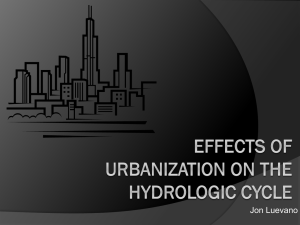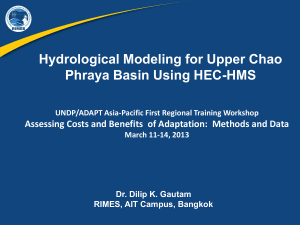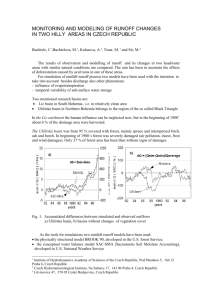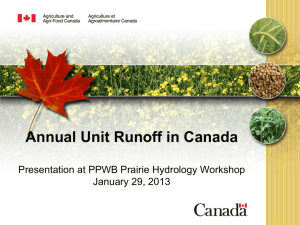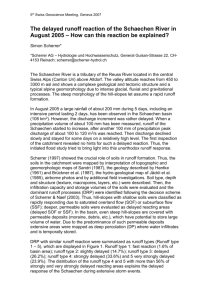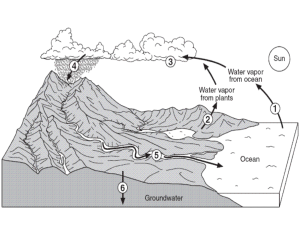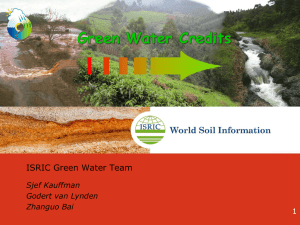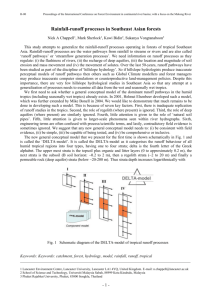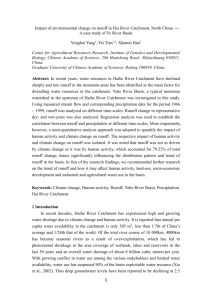Monitoring and modelling of water quantity and chemistry to identify
advertisement
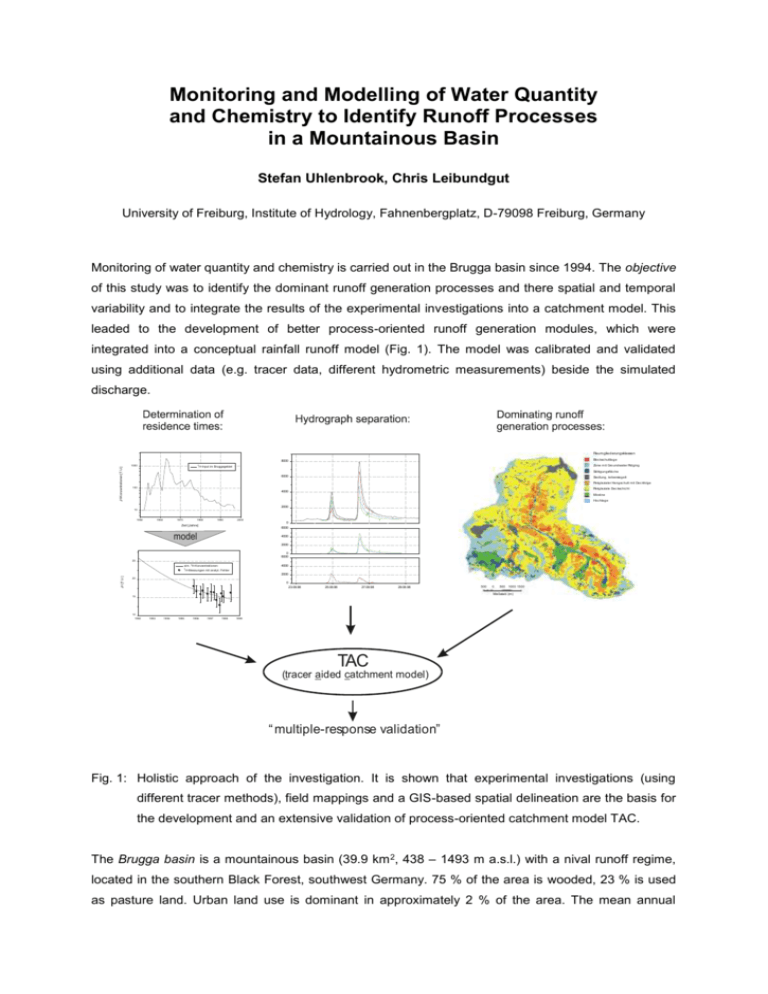
Monitoring and Modelling of Water Quantity and Chemistry to Identify Runoff Processes in a Mountainous Basin Stefan Uhlenbrook, Chris Leibundgut University of Freiburg, Institute of Hydrology, Fahnenbergplatz, D-79098 Freiburg, Germany Monitoring of water quantity and chemistry is carried out in the Brugga basin since 1994. The objective of this study was to identify the dominant runoff generation processes and there spatial and temporal variability and to integrate the results of the experimental investigations into a catchment model. This leaded to the development of better process-oriented runoff generation modules, which were integrated into a conceptual rainfall runoff model (Fig. 1). The model was calibrated and validated using additional data (e.g. tracer data, different hydrometric measurements) beside the simulated discharge. Raumgliederungsklassen Bloc ksc huttlage 3 Zone mit Groundwater Ridging H-Input im Bruggagebiet Sättigungsfläc he 6000 Abfluß [l/s] 3H-Konzentrationen [T.U.] 8000 1000 100 Siedlung, teilversiegelt Periglazialer Hangsc hutt mit Dec kfolge Periglaziale Dec ksc hic ht 4000 Moräne Hoc hlage 2000 10 1950 1960 1970 1980 1990 2000 0 Zeit [Jahre] 6000 Abfluß [l/s] model 4000 2000 0 6000 Abfluß [l/s] 25 3 sim. H-Konzentrationen H-Messungen mit analyt. Fehler 20 4000 2000 0 3H [T.U.] 3 23.08.98 25.08.98 27.08.98 29.08.98 500 0 500 1000 1500 Maßstab (m) 15 10 1992 1993 1994 1995 1996 1997 1998 1999 TAC (tracer aided catchment model) “ multiple-response validation” Fig. 1: Holistic approach of the investigation. It is shown that experimental investigations (using different tracer methods), field mappings and a GIS-based spatial delineation are the basis for the development and an extensive validation of process-oriented catchment model TAC. The Brugga basin is a mountainous basin (39.9 km 2, 438 – 1493 m a.s.l.) with a nival runoff regime, located in the southern Black Forest, southwest Germany. 75 % of the area is wooded, 23 % is used as pasture land. Urban land use is dominant in approximately 2 % of the area. The mean annual precipitation amounts to 1750 mm, generating a mean annual discharge of 1220 mm. The crystalline bedrock consists of gneiss and anatexits. The bedrock is covered by a debris and drift cover, which consists of moraines and periglacial deposits. In the experimental part of this study hydrograph separations were performed for different events using 18O, dissolved silica and chlorid as tracers. In addition, concentrations of the main anions (Cl -, NO3-, SO42- and PO43-) and cations (Na+, K+, Ca2+, Mg2+) in stream discharges and in wells provided further information about the runoff generation processes. Using the environmental tracers 18O, 3H and freon concentrations the residence times of the water in the different flow systems were evaluated. In addition, the amounts of runoff components from specific source areas were determined for a period of three years. Three main runoff components were identified: Direct runoff is generated on saturated areas, sealed areas and boulder trains. During short periods of a few hours this component can contribute up to 50 % of total stream discharge, for longer periods (several years) the contribution amounts to somewhat more than 10 %. The aquifers of the slopes contribute about 70 % of total discharge (shallow groundwater). The mean residence time of the water in these reservoirs is between two and three years. With soil water displacement effects these reservoirs contribute to flood generation, however they are also important for base flow. The deeper groundwater originates from the hilly uplands and the crystalline hard rock aquifer and generates mainly base flow. The mean residence time of the water is approximately 6 – 9 years. For a period of three years the contribution of this component was estimated 20 %. Based on the experimental investigations and using different spatial information (i.e. geology, drift cover properties, topography and further maps) zones with the same dominating runoff generation processes were delineated. In order to achieve this, a specific method was developed, which accounted for the characteristics of the study site and the available data. The spatial delineation is needed for the semi-distributed catchment model TAC (tracer aided catchment model). The model is a conceptual model, which implies that complex hydrological processes are conceptualized using relatively simple routines. The snow routine is based on the degree day method. The soil routine was adopted from the HBV model. The runoff generation routine was created new, therefore specific storage routines were developed for all zones with the same dominating runoff generation processes. Concentrations of natural tracers (e.g. dissolved silica) can be attributed to the different runoff components derived by by the TAC model. Consequently, the simulation of the tracer concentration in the discharge is possible. The quality of the TAC results can be assessed by the agreement of the simulated and the observed tracer concentration in the relation to the efficiency of the runoff simulation. The application of TAC in the Brugga basin, different subbasins and a neigbouring basin produced reasonable results. The results of the rainfall runoff modelling on a daily basis was at least as good as the simulations using other conceptual models (i.e. TOPMODEL, HBV, PRMS). The model was validated in a first step using an independent period. In a next step, an extensive model validation on internal stages and flows was performed using additional information (multiple-response validation). Therefore, the modelling of the discharge in different scales, runoff components and silica concentrations were compared with measurements. A good agreement of simulated and observed variables was reached. The following conclusions can be drawn: (1) The modelling approach of TAC, which is based on the spatial delineation of zones with the same dominating runoff generation processes, and the conceptualization of the runoff generation processes is suitable for an improved process oriented modelling. (2) The potential of tracer methods was demonstrated. They are powerful tools for identifying the runoff generation at a catchment scale. Based on these findings better process oriented modelling concepts can be developed. The information from tracers (e.g. tracer concentrations, calculated runoff components) can be used to validate or disprove a modelling concept.
